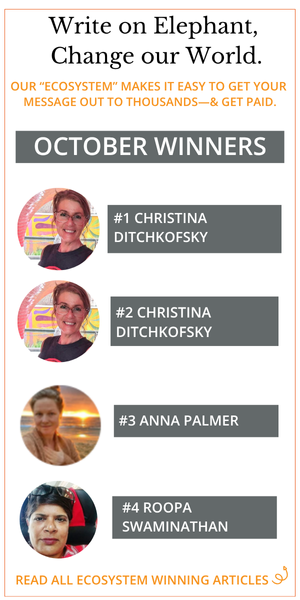*Did you know you can write on Elephant? Here’s how—big changes: How to Write & Make Money or at least Be of Benefit on Elephant. ~ Waylon
It was a warm spring afternoon near Nairn, Scotland, where I spent three months doing my first work exchange in a biodynamic garden.
I was sitting in the kitchen, soaking up the amber rays of the sun, with a steaming cup of nettle tea warming my palms. I remember this day vividly—the scent of our lunch still lingering around the house, the uneven sides of the handmade cup I used to like so much, birds chirping on the bushes outside the window.
It was the day when I got introduced to the work of Deb Dana by Craig, who was living with us, in his car in the garden. He’s one of the brightest people I have ever met, someone you never forget even if you just see them passing by on the street. Craig’s tall, so it’s easy to spot him anywhere, but what engraves him in your memory is the wonderful smile he gifts everyone with. Understandably, he was known around the area as Smiley Craig.
Deb Dana is a Maine-based licensed clinical social worker whose work centers on complex trauma. We can thank the term “glimmers” to her as well that was introduced by Dana to make the complex polyvagal theory more accessible in her 2018 book The Polyvagal Theory in Therapy. Simply put, glimmers are small moments that bring you joy or peace, which can help cue our nervous system to feel safe or calm. Probably I remember that day in the kitchen with Craig like it happened yesterday because every minute of it was filled with glimmers.
“Glimmers are these micro-moments of safety, connection, regulation. It is the tiny moments of joy, the moments of ‘okayness’ that take us away from being stuck in this challenging world we’re in, or our own trauma that’s sitting unprocessed, and it…helps build the capacity to then manage these other things in a different way,” said Dana told HuffPost in an interview. “Glimmers are a reminder that our nervous system is so amazingly able to hold all of the trauma and…notice the micro-moments of joy, of safety, of connection, of whatever the flavors we want to talk about.” This is especially true for people with a history of trauma, depression, or anxiety who may have a harder time feeling safe and secure.
Glimmers can be found in different places and senses. Me fellow tree planters always note how much they love about me that I am able to notice tiny things and be genuinely happy for them, which sparks the light of joy in them as well, especially when we work on a hard site or deal with bad weather conditions.
I often find myself ruminating on bad stuff going on in my life or my past, which can lead me in a downward spiral and my brain starts to notice too much negativity. I never knew before that there’s a name to this and that seeking out glimmers was an actual practice; I just loved to look out for small things or moments that help me feel more centered, grounded, and calm again and remind me to be grateful and that there are still beautiful and amazing things in life. For me, it’s like a reset button from where I am able to move on with a clearer head space and motivation.
“You feel something happen inside, there’s an energy that happens around a glimmer, and your brain then marks it as well.” ~ Deb Dana
Some of my favorites glimmers include:
>> Looking up the sky to discover a beautiful rainbow
>> Seeing bright stars in the sky, especially when I notice a constellation I know the name of
>> Noticing a stranger smiling on the street
>> The child-like laugh of someone
>> Petting and hugging random animals
>> My favorite song coming up on the radio
>> Spotting the wild flower I was named after (Centaurea in latin, or Imola in Hungarian)
>> Experiencing a beautiful sunrise from the car while driving to work
>> The first sip of a hot tea from my favorite cup
>> Hot lunch on a cold working day
>> The wind blowing away crunchy autumn leaves
>> Wrapping a soft blanket around my body
>> The smell and sound of rain
>> My cat purring
>> My partner pulling me closer in his sleep
There are different types of glimmers, Dana noted. “Glimmers that make me happy, glimmers that make me feel peace, glimmers that bring a sense of magic.”
Our glimmers are also unique and subjective due to biodiversity or the fact that each of us are different with our own set of experiences, preferences, and values.
Dana invites people to set what she calls a “glimmer intention.” You may decide “I’m going to look for one glimmer before lunch.”
“We want to start small because for many people, finding a glimmer is a challenge. For people who have lived in a trauma-saturated life, it’s hard to look outside of that. You can also keep a glimmer journal to write down what you discovered and reflect at the end of the day. And because we’re wired for connection, if there’s someone else in your life who wants to go on a ‘glimmer journey’ with you, you can share your glimmers with them, which brings them alive,” Dana explains.
Personally, I love taking pictures and videos of glimmers that I can later share with others in my Instagram or TikTok account. I also love to reflect on my findings in my gratitude journal and read them back at times when I struggle and can’t go on a glimmer expedition.
“What is a glimmer for you might be a trigger for me,” Dana added. “It doesn’t mean it’s right or wrong; it simply means this is how our nervous systems experience this moment.”
Triggers are cues that signal potential threat and can make us feel anxious and withdrawn, stressed. For example, someone might find peace in watching the sunset over the ocean, while someone else is terrified by deep waters and wouldn’t even go near it. Hence it’s crucial to identify our glimmers too and not only be aware of what our triggers are. Understanding and knowing glimmers of others can also bring more glimmers into our lives. Glimmering up a loved one’s life promotes not only feelings of joy, peace, and safety, but deeper connectivity with the person and more groundedness in the relationship.
“There’s something about that that I think is powerful, that knowing that I can look at other people’s glimmers and get a sense of them through their glimmer,” Dana said.
But it’s important not to mix up glimmers with toxic positivity. It’s not to suppress our emotions at the moment or pretend a difficult situation doesn’t exist. Our hard times and our triggers are here to teach us and help us grow if we are mindful with them and willing to work with them. The first step on this way might start with exploring your glimmers, as Dana mentioned too; they co-exist with everything else and you’ll be able to spot them even in the darkest days and with practice, you just get better at it.
~
{Please consider Boosting our authors’ articles in their first week to help them win Elephant’s Ecosystem so they can get paid and write more.}


 Share on bsky
Share on bsky





Read 5 comments and reply